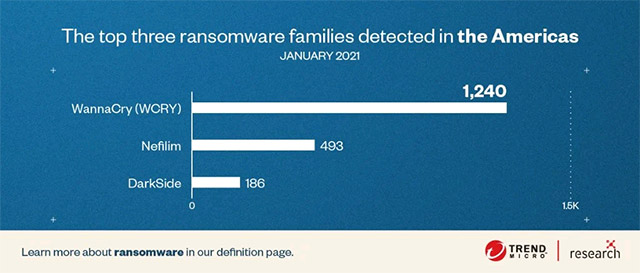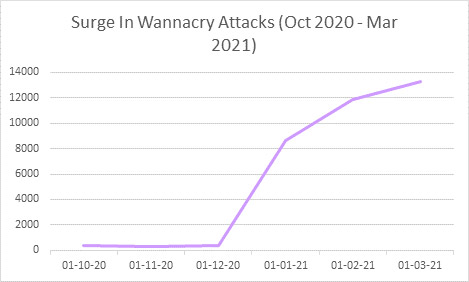The attack on Microsoft Exchange increased while WannaCry showed signs of return
The reason is simple, the patch has been released by Microsoft to Exchange Server users around the world, but it will certainly take a long time for these updates to be fully applied due to Microsoft Exchange users. organizations and businesses are known primarily for delays in applying changes to their systems.
Indeed, recent statistics from cybersecurity firm Check Point have shown a significant increase in the number of attacks targeting the critical vulnerability cluster ProxyLogon existing on Microsoft Exchange servers. Meanwhile, Palo Alto Networks claims to have at least 125,000 unpatched servers worldwide. That means these are all potential targets for cybercriminals.
Even as Microsoft actively accelerates the distribution of patches to partners from March 2, 2021, the number of Exchange Server attacks continues to increase sharply, specifically tripling globally, up to to tens of thousands of recorded cases to date.
The Microsoft Exchange vulnerability still appeals to cybercriminals
As of March 14, there are about 82,000 vulnerable Exchange servers around the world, according to Microsoft's internal research. About a week later, that is, by the end of March, this number has dropped significantly to about 30,000 exposed servers, according to data from RiskIQ. Despite the sharp decline, the number is still quite high, showing that ProxyLogon vulnerabilities in Exchange Server are still an attractive target for hackers.

Check Point's remote survey data last week showed more than 50,000 attack attempts globally involving Exchange Server, mostly targeting organizations in the government / military, manufacturing and banking sectors /. finance.
Microsoft Exchange Server is a popular email collaboration, calendar, and mailbox solution in the enterprise community. Users of this server are diverse, from giant corporations to small and medium businesses around the world. Therefore, successfully exploiting vulnerabilities in Exchange Server opens cybercriminals a huge opportunity to gain illegal profits from victim businesses.
Additionally, Microsoft says a ransomware variant called DearCry is taking advantage of the vulnerabilities to deploy ransomware on vulnerable Exchange servers.
WannaCry tends to make a comeback
In related news, despite being 'defeated' at the end of 2017, the number of security breaches related to the infamous WannaCry ransomware is showing signs of rebound.
In fact, this situation is in line with the general trend in the number of ransomware attacks worldwide in the past few months.
According to Check Point statistics, there has been a 57% increase in the number of ransomware attacks recorded in the past six months at a global level. More worrisome, the monthly increase since the beginning of 2021 is 9%.
Besides the commonly observed ransomware strains (Maze, Ryuk, REvil), Check Point noted that the number of organizations affected by WannaCry has increased by 53%.
' We found that the number of organizations affected by WannaCry increased more than 40 times in March 2021 compared to October 2020. New samples still use the EternalBlue exploit to spread the malware - has been with patches for more than 4 years ".
WannaCry ransomware spreads itself on computers using Windows operating systems. After being first discovered in May 2017, it quickly became one of the worst nightmares in the history of global cybersecurity with hundreds of thousands of computers infected, causing billions of losses. USD, followed by the collapse of countless businesses accidentally became victims.
With the efforts of all mankind, WannaCry is said to have been 'defeated' by the end of 2017. But in fact, it is not only not eradicated, but also showing signs of resurgence recently. .
Global security organizations continue to detect WannaCry every day, including many new variants that were designed to bypass patches aimed at it before. In January, for example, a new variant of WannaCry reached the top of the most popular ransomware in the US.

The reason behind this bizarre trend is because WannaCry has deep access to thousands of systems that are still vulnerable to EternalBlue now accessible over the public internet.
Check Point observes a similar trend starting December 2020, with the number of attacks continuing to grow by more than 12,000 by March 2021.

Thus, it can be seen that WannaCry is in fact still one of the popular and destructive malware types today. Raising vigilance against this ransomware strain is essential and should not be taken lightly.
You should read it
- Vulnerability causes Exchange servers to 'crash' around the world: Microsoft offers a fix method
- Switch from Exchange 2000/2003 to Exchange Server 2007 (part 1)
- Transfer from Linux Mail Server to Exchange Server 2007 (Part 1)
- Discover EMC in Exchange Server 2010 (Part 2)
- Exchange Server 2007: ten minutes of instruction
- Transfer Exchange 2003 to Exchange 2007 (Part 2)
- Microsoft continues to 'delay' the plan to launch a new version of Exchange Server for another 4 years
- Transfer Exchange 2003 to Exchange 2007 (P.7)
May be interested
- What is WannaCry, how to prevent Wanna cry for computers
 the wannacry virus has made waves and caused a lot of damage to computer users. if you still don't know what wannacry is and how to prevent wannacry on your computer, please follow the article below and find the answer for yourself.
the wannacry virus has made waves and caused a lot of damage to computer users. if you still don't know what wannacry is and how to prevent wannacry on your computer, please follow the article below and find the answer for yourself. - Download the free WannaCry malware checker now
 the free wannacry malware checking tool is released from bkav, capable of checking whether a computer contains an eternalblue vulnerability. this is the flaw that wannacry took advantage of to invade the computer.
the free wannacry malware checking tool is released from bkav, capable of checking whether a computer contains an eternalblue vulnerability. this is the flaw that wannacry took advantage of to invade the computer. - 2 effective and free ways to check WannaCry
 you are worried whether your computer is infected with wannacry ransomware, how to know if there are any vulnerabilities in the system as well as how to check wannacry malware. how to check wannacry or check ransomware wannacry effectively and for free with bkav checkwancry and vnist scanner tools will help you do that.
you are worried whether your computer is infected with wannacry ransomware, how to know if there are any vulnerabilities in the system as well as how to check wannacry malware. how to check wannacry or check ransomware wannacry effectively and for free with bkav checkwancry and vnist scanner tools will help you do that. - Microsoft unhappy with customers using old version of Exchange, announces support deadline
 earlier this month, microsoft announced exchange server subscription edition (se), marking the official transition of the product to the modern lifecycle policy.
earlier this month, microsoft announced exchange server subscription edition (se), marking the official transition of the product to the modern lifecycle policy. - A month before your heart attack, your body will show 8 warning signs!
 here are 8 important warning signs that may appear 1 month in advance or even earlier, indicating that you may have a heart attack. invite you to consult!
here are 8 important warning signs that may appear 1 month in advance or even earlier, indicating that you may have a heart attack. invite you to consult! - WannaCry is not dead yet, it just attacked Honda and Australia's traffic camera system
 a month has passed since wannacry caused chaos around the world, we are starting to mention it as a phrase of the past, but ... wannacry hasn't died yet ...
a month has passed since wannacry caused chaos around the world, we are starting to mention it as a phrase of the past, but ... wannacry hasn't died yet ... - What is Volumetric DDoS Attack?
 volumetric ddos attack is designed to overwhelm internal network capacity with large volumes of malicious traffic. volumetric ddos attack is usually performed against a specific target
volumetric ddos attack is designed to overwhelm internal network capacity with large volumes of malicious traffic. volumetric ddos attack is usually performed against a specific target - Shade ransomware, the nightmare of 5 years ago is showing signs of returning
 shade ransomware - extortion code recorded by kaspersky labs disappeared from the internet five years ago, 2014, showing signs of returning again.
shade ransomware - extortion code recorded by kaspersky labs disappeared from the internet five years ago, 2014, showing signs of returning again. - Introducing Exchange Server 2019, how to install Exchange Server 2019
 exchange server 2019 is designed to deliver security, performance, and improved manageability and operations - properties microsoft's biggest customers have come to expect from exchange.
exchange server 2019 is designed to deliver security, performance, and improved manageability and operations - properties microsoft's biggest customers have come to expect from exchange. - The unpatched Microsoft Word DDE vulnerability is exploited in a massive malware attack
 a new attack method that exploits the microsoft office integration feature has been discovered being used for malware distribution campaigns.
a new attack method that exploits the microsoft office integration feature has been discovered being used for malware distribution campaigns.










 How to check your Facebook information is leaked or not
How to check your Facebook information is leaked or not Microsoft warns of an increasing trend of attacks targeting firmware and worrying public indifference
Microsoft warns of an increasing trend of attacks targeting firmware and worrying public indifference Malicious code is hidden in cheats and mods that target the gaming community
Malicious code is hidden in cheats and mods that target the gaming community A ransomware declared decommissioned and refunded the ransom to the victim
A ransomware declared decommissioned and refunded the ransom to the victim QNAP provides an emergency warning about NAS device attack trends, showing how to secure NAS devices
QNAP provides an emergency warning about NAS device attack trends, showing how to secure NAS devices Detect new Android malware fake system update to track and steal user information
Detect new Android malware fake system update to track and steal user information